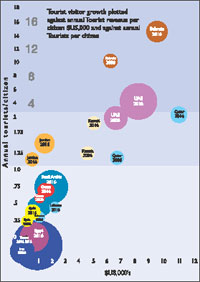
Economic, demographic, social and environmental sustainability have to be considered by the Middle East’s tourism players when formulating long-term industry policy, according to a pioneering study carried out by Global Futures and Foresight (GFF), an international strategic futures think-tank.
The Vision to 2020 report, covering 13 countries, is the first of three in-depth studies on the Middle East’s travel and tourism industry’s future prospects, sponsored by Reed Travel Exhibitions (RTE), organiser of the Arabian Travel Market.
It is a first for the region and outlines the main challenges and opportunities ahead. These include the need to identify market segments interested in its luxury attractions, flexibility so that demand doesn’t lag behind supply, possible effects from a climate disaster or disease outbreak and even the impact of water availability.
Achieving collaboration with other destinations and creating a hassle-free traveller experience, should also be considered, according to the report.
“The region has the ambition, resources and commitment to turn vision into reality. The challenge is to ensure the long term viability of those strategies,” said David Smith, GFF joint chief executive and co-author of the pathfinder report.
He said the region has already created original developments like the Palm Islands and The Pearl-Qatar, but the international character of many others could place them in any city, from Stockholm or San Francisco to Dubai. “The Middle East now faces the challenge to drive the next wave of innovation that emphasizes, celebrates and promotes the region’s cultures, heritage and tradition.”
Vision to 2020, covering the Middle East and North Africa, aimed at identifying the drivers and barriers of the tourism industry and developing scenarios on possible impacts.
A second report, including comprehensive industry data, will be revealed at the WTM in London this November. The final study, A Response from the Region, containing detailed findings from regional industry leaders – will be presented at ATM 2008.
“Current estimates suggest that over the next 20 years, upwards of $3 trillion is going directly into leisure and tourism and into the supporting infrastructure. Through projects announced to date, by 2020 the region will add airport capacity for 300 million extra passengers, build over 200 new hotels, add 100,000 additional rooms, grow visitor numbers to over 150 million and increase the size of its aircraft fleet over 150 per cent by 2025,” said Smith.
However, said Gornall, “There is no one single certain future that we are moving towards and no one outcome,” inviting other parties interested in the future of the Middle East’s travel and tourism market to back this ground-breaking project.
The region’s travel and tourism prospects will also be influenced by global political, economic, social, demographic, technological and environmental factors and trends, according to the Vision to 2020 blueprint.
An economic power shift is expected that will open up new target markets for both inbound and outbound visitors and investors, while the growth and ageing of the global population will impact the level of disposable income. Rising wealth levels, particularly in Asia, means regional players will need to decide which sectors of the market they target, from new airlines and hotels to leisure services.
Other key trends, also affecting the paths the Middle East tourism industry could take, include increasing demand for health tourism, sensitivity towards environment protection, an estimated creation of 1.5 million new jobs in the next decade, the amplified role of Information Communi-cation Technology and aviation breakthroughs.
A matter of particular importance to the region highlighted in the study is security. It says a concerted effort will need to be made to address this issue as the Middle East suffers from a collective identity in a way that other regions don’t.
As for competition, the report warns that a number of new travel alternatives will emerge, while the world economic map will look different by 2020, with countries like Pakistan, Indonesia and Nigeria possibly amongst the 20 largest by 2050.
